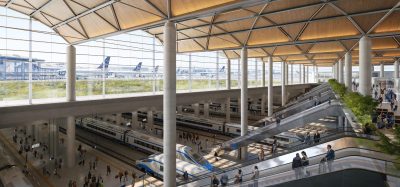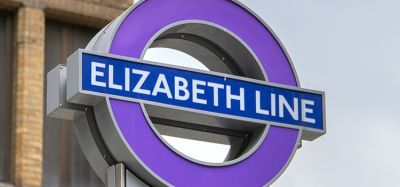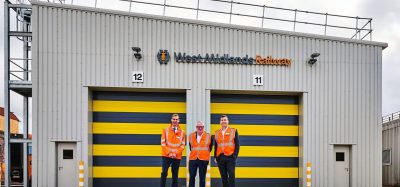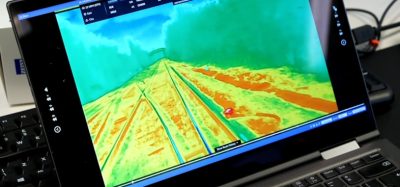Winter is coming – how does NS and ProRail cope?
Posted: 28 November 2016 | Raja Schmidt (NS) | No comments yet
Snow and frost can have a major impact on train timetables. NS is the largest rail carrier in the Netherlands and together with the network manager, ProRail, it has a number of measures ready and waiting to ensure it can keep transporting as many passengers as possible when winter comes. The core measures are timetable adjustments and good communication, and the same approach can also be used for when heavy storms occur. Raja Schmidt, NS’s Senior Business Consultant – Quality & Innovation, provides an in-depth look at what these measures are and how the help NS and ProRail provide enables reliable train services during extreme weather.
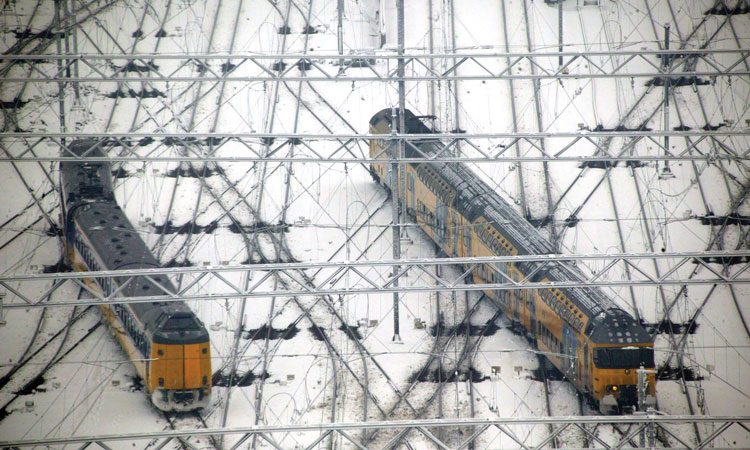

The majority of NS staff do not like thinking back to 3-4 February 2012. Train traffic in the Netherlands was out of control due to heavy snowfall and extreme frost. Pictures of large groups of stranded passengers at numerous stations dominated the news programmes. It was not the first time that train traffic had been disrupted by severe weather and NS and ProRail had already been developing measures since 2010. However, everyone could clearly see that the existing series of measures was not sufficient to give passengers the full picture and the right information in the event that they travelled on these kinds of days. A central question for NS and ProRail is how we can offer reliable transport to passengers, even in extreme weather.
Frozen points
The Netherlands is not like Switzerland, with its snowbound Alpine peaks and white mountain valleys. Even so, winter weather can cause a lot of problems on a few days every year. The key issues are frozen points, increased technical problems with the trains and icing on the overhead lines. Because the Netherlands has one of the world’s busiest rail networks with a lot of points, such problems rapidly create a major impact on the entire timetable. Faults with points or stranded trains at critical locations can create substantial infrastructural issues that can no longer be solved with tweaks and adjustments. On the most extreme winter days we even had trouble keeping track of exactly where all the trains, drivers and conductors were. On-the-fly adjustments on the day
itself, quickly and responsively, proved to be too complex.
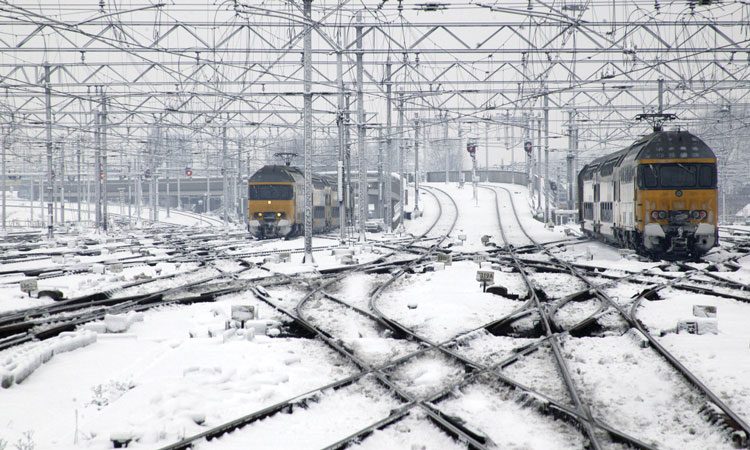

The Netherlands has one of the world’s busiest rail networks with a lot of points so ProRail uses heating systems for the points to ensure tracks remain operational as best as possible during extreme winter temperatures
Modified timetable
These experiences demonstrated to NS and ProRail the old adage that prevention is better than cure. Together we developed a number of scenarios for running a modified timetable if winter weather is expected. We agreed this idea with the consumer organisations and the franchise authority, the Ministry of Infrastructure and the Environment. Extensive communications efforts mean that 99% of rail passengers know before winter starts that NS may operate a modified timetable in winter weather. The majority of them (84%) are neutral or positive about this.
When a modified timetable is in effect, fewer trains run than on a normal day. On most routes in the Netherlands trains then run every half hour instead of every 15 minutes. Pre-planning fewer trains on the most important and busiest routes means that additional adjustments will be needed less quickly on the days affected by winter weather (adjustments: tweaking the deployment of staff and rolling stock on the day itself if unexpected conditions arise, plus timetable changes if necessary). If adjustments are still needed, organising them is less complex. Fewer trains allows breathing space and bottlenecks are
formed less quickly.
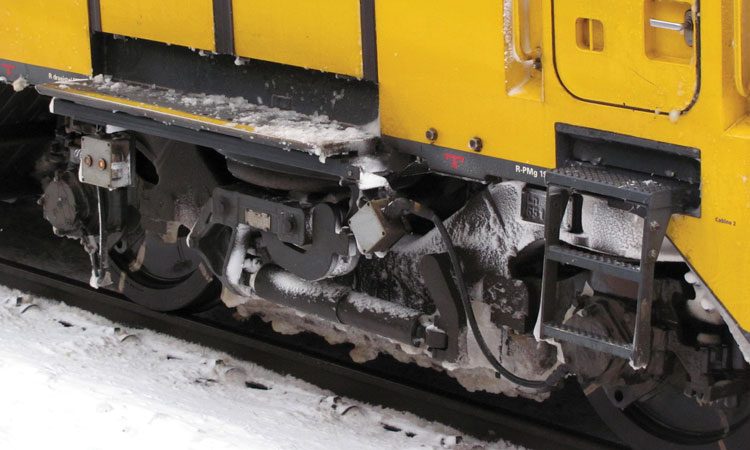

To prevent snow and ice build-up on rolling stock, NS use anti-icing treatments to ensure trains can keep running
We have based the plans on a small number of variants: a modified timetable for the whole of the Netherlands (on the routes operated by NS, that is; other carriers operate at the periphery of our network) and five regional scenarios. Because the intensity of the timetable is not the same every day, the so-called Reduced National Timetable has three variants: for weekdays, Saturdays and Sundays. Owing to the fact that we already run fewer trains on Sundays, for instance, fewer modifications are needed to produce the same effect. The scenarios for regional scaling down give us the ability to ‘cut off’ parts of the network from the larger whole in the event of regional weather extremes. Trains will still be running there, but the timetable in that area is virtually disconnected from that of the country as a whole. This reduces the nationwide impact of regional disruptions.
Fixed criteria for changes
There are two preconditions that have to be met before the modified timetable can be used effectively: clear warning criteria and a proper decision-making process. Addressing the subject of the criteria; the decision-making process is triggered when the following threshold values are expected:
- Snow – a 10% chance of 3cm of snow somewhere in the Netherlands
- Frost – more than a 50% chance and temperature less than 10°C
- Storm – more than a 20% chance of wind gusts of greater than 110km/h between 1 November and 1 May.
We adopt a stricter criterion for the first snowfall of the season – a 10% chance of 1.5cm of snow in the broader Randstad metropolitan area – which is the most densely populated part of the Netherlands and the area where the most trains run. Adopting the motto ‘better safe than sorry’ we will make the adjustments sooner the first time.
Are changes needed?
The decision-making process starts the day before. Supposing that we know early in the morning that there is a 10% chance of at least 3cm of snow somewhere in the Netherlands on the next day; at this point (‘Day 0’) we basically use the following working method:
Day 0
Overnight, the weather forecasting agency notes that a criterion will be exceeded. This marks the start of the decision-making phase – preparing for the modified timetable: are we going to prepare for a modified timetable or not?
08:00 – the control team of the OCCR (traffic control centre for the railways) issues a recommendation to the LBI (national incident management policy team).
09:00 – the LBI assesses that recommendation and issues advice to the CBT/CMT (crisis policy and crisis management teams) about preparatory measures.
09:30 – the CBT/CMT, which contains NS and ProRail board members, gives a ‘go’ or ‘no-go’ for the preparations for modifying the timetable. During this meeting the CBT/CMT receives advice from experts on communication, infrastructure and rolling stock, and from the LBI. In the case of a ‘go’, preparation teams from various departments will start preparing the modification. That can range from the planning and logistics departments through to communications and journey information. On rare occasions a ‘no-go’ decision is given despite the criterion being exceeded. This could, for instance, be because the modification is not expected to have much effect because the exceeded criterion affects an area that is too small, or if it is expected that the damage to our reputation will be excessive (the cure worse than the disease).
15:00 – going through the decision-making phase: this is when the CBT/CMT makes the definitive decision about whether or not to run the modified timetable. At this point too, it receives advice from experts on communication, infrastructure and rolling stock, and from the LBI. If we do not make the change, then all the preparatory work has in principle been for nothing. If the decision to run a modified timetable is taken, NS communicates this internally and externally from 16:00 onwards. The modified timetable for the next day will be visible in our online journey planner from 19:00 onwards.
Day 1
NS runs using a modified timetable. Throughout the day we keep a close eye on the effects of the measures we have taken. Owing to the expected additional crowding, we put additional associated measures into effect that were also prepared on Day 0, such as:
- Additional alternative transport, catering, extra services and crowd management capacity
- Deploying extra staff at stations to help answer questions
- Keeping the platforms free of snow.
Day 1 is often another Day 0 – after all, snowfall can often last for several days. The decision-making process then repeats, as aforementioned.
Other measures
Modification of the timetable is a measure that a carrier would rather not choose. NS and ProRail are therefore working on making the infrastructure and the trains more robust. For the rolling stock, for instance, this involves anti-icing treatments to prevent accumulations of ice falling off the trains and into the points, and hot air cannons to thaw-out defective rolling stock. For infrastructure ProRail uses heating systems for the points and can deploy trains for removing ice from the overhead lines. In addition the network manager ensures that repair teams or snow teams can be on the spot quickly to keep the
tracks and the points operational.
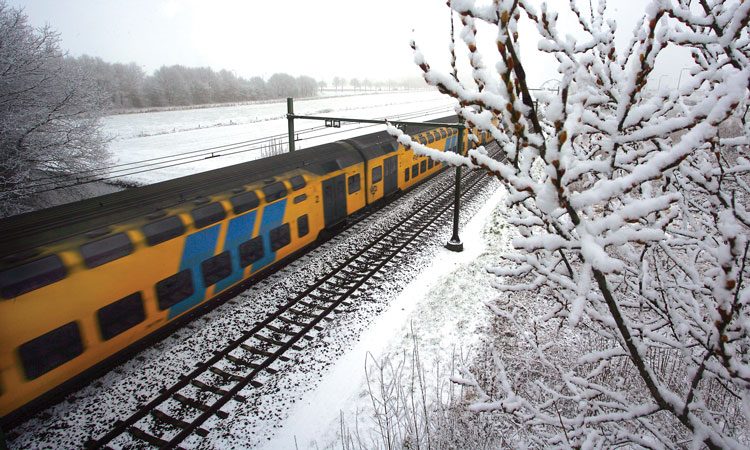

NS and ProRail deploy a series of ‘winter’ measures to ensure trains operate as efficiently as possible during harsh winter weather
When it isn’t winter? Remain alert
With an average temperature in De Bilt of 6.3°C, the winter of 2015-2016 was the second mildest since regular temperature records began in 1706. Passengers and stakeholders have largely forgotten the severe winters of 2009-2012 and our operational performance has improved over recent years. Nevertheless, NS does not expect that the timetable will continue to run with little or no disruption in severe winter weather.
At the time of writing this article (October 2016) we had had zero ‘black’ days in 2016 (days on which the punctuality is less than 75% and/or train cancellations are at over 10% – note: this can also be caused by a major power cut). Over recent years NS and ProRail have taken steps to improve performance during winter conditions with the help of the annual winter weather programme. Our aim, whether it is winter or not, is to provide reliable transport and efficient journey information for passengers under virtually any conditions. Until we have achieved that, modified timetables are an appropriate way of keeping the train services under control.
The follow-up will focus on continuing and above all maintaining the working methods that have been set up. We are, for instance, working on system-wide improvement of the points and fundamental improvements in the control and adjustment of train services. NS and ProRail will keep looking for areas where things can be done better, based on new experience gained by us and by our colleagues abroad.
Another challenge: Autumn
The foundations for the winter measures are ready. But the autumn also means that many carriers – including NS – will be struggling with disruptions to the timetable. Leaves on the tracks in particular cause a lot of problems. Slippery tracks mean that drivers have to go more slowly to prevent them slipping. This is of course safer, but also means that the journey time is longer. NS and ProRail are jointly investigating how we can make sure that we run a reliable timetable during autumn as well. We will be focusing on driving safely, preventing slipperiness, and tackling and mitigating damage to our public image. In addition to the annual application of sandite to combat slipperiness, we are carrying out several years of testing for better grip on the rails: looking at, for example, a laser train; water spraying equipment; vegetation management; and driving behaviour.
An intensively-used rail network
The rail network in the Netherlands is heavily used. NS is the key passenger carrier in the Netherlands and:
- Carries approximately 1.2 million passengers a day
- Operates approximately 5,500 trains every day
- Has approximately 2,500 drivers and 3,000 conductors.
ProRail is the infrastructure manager in the Netherlands that:
- Manages over 7,000km of track
- Manages more than 7,000 sets of points
- Manages over 2,500 crossings.


Issue
Related topics
Adverse Weather, Timetabling/Scheduling, Track Systems, Track/Infrastructure Maintenance & Engineering



